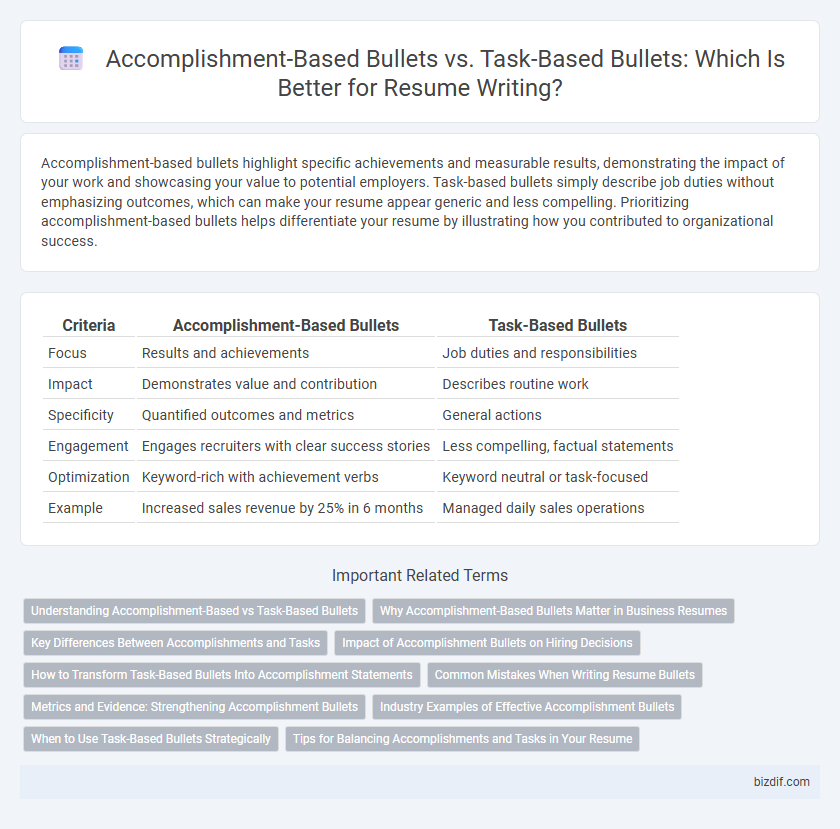Accomplishment-based bullets highlight specific achievements and measurable results, demonstrating the impact of your work and showcasing your value to potential employers. Task-based bullets simply describe job duties without emphasizing outcomes, which can make your resume appear generic and less compelling. Prioritizing accomplishment-based bullets helps differentiate your resume by illustrating how you contributed to organizational success.
Table of Comparison
| Criteria | Accomplishment-Based Bullets | Task-Based Bullets |
|---|---|---|
| Focus | Results and achievements | Job duties and responsibilities |
| Impact | Demonstrates value and contribution | Describes routine work |
| Specificity | Quantified outcomes and metrics | General actions |
| Engagement | Engages recruiters with clear success stories | Less compelling, factual statements |
| Optimization | Keyword-rich with achievement verbs | Keyword neutral or task-focused |
| Example | Increased sales revenue by 25% in 6 months | Managed daily sales operations |
Understanding Accomplishment-Based vs Task-Based Bullets
Accomplishment-based bullets highlight measurable achievements and the impact of actions taken, emphasizing results such as increased sales by 20% or streamlined processes reducing costs by 15%. Task-based bullets focus on duties and responsibilities performed in a role without quantifying outcomes, such as managing schedules or coordinating meetings. Understanding the difference allows job seekers to craft resumes that effectively demonstrate value and performance rather than merely listing functions.
Why Accomplishment-Based Bullets Matter in Business Resumes
Accomplishment-based bullets highlight measurable results and specific achievements, demonstrating an applicant's direct impact on previous employers. These bullets showcase skills through quantifiable outcomes such as revenue growth, cost savings, or process improvements, making the resume more compelling to hiring managers. Emphasizing accomplishments increases the likelihood of passing Applicant Tracking Systems (ATS) by incorporating relevant keywords tied to business success.
Key Differences Between Accomplishments and Tasks
Accomplishment-based bullets highlight measurable outcomes and the impact of actions, demonstrating how specific efforts contributed to organizational success, while task-based bullets list routine responsibilities without quantifying results. Accomplishments use action verbs paired with quantifiable metrics, reflecting problem-solving and goal achievement, whereas tasks describe job duties without showcasing value added or improvements. Emphasizing accomplishments in resumes improves clarity and effectiveness by showcasing professional expertise and results-driven performance.
Impact of Accomplishment Bullets on Hiring Decisions
Accomplishment-based bullets highlight measurable achievements and specific results, making resumes more compelling to hiring managers by showcasing candidates' tangible contributions. This approach effectively demonstrates problem-solving skills and adds quantifiable value, increasing the likelihood of interview opportunities. Employers prioritize accomplishment-based bullets as they provide clear evidence of potential impact and job performance.
How to Transform Task-Based Bullets Into Accomplishment Statements
Transform task-based bullets into accomplishment statements by quantifying results, emphasizing specific achievements, and highlighting the impact of your actions on the organization. Use action verbs combined with measurable outcomes, such as percentage increases, time saved, or revenue generated, to clearly demonstrate value. This approach shifts the focus from routine duties to tangible contributions, making your resume more compelling to employers.
Common Mistakes When Writing Resume Bullets
Common mistakes when writing resume bullets include using task-based bullets that simply list duties without demonstrating impact or results, which fails to capture the applicant's value. Many candidates overlook incorporating quantifiable achievements and action verbs, leading to bland and unimpressive statements. Effective accomplishment-based bullets highlight specific outcomes like increased sales by 20% or streamlined processes, making the resume more compelling to recruiters.
Metrics and Evidence: Strengthening Accomplishment Bullets
Accomplishment-based bullets emphasize measurable results by incorporating specific metrics and evidence, such as percentage increases in sales or project completion times, to demonstrate impact. These quantifiable achievements provide recruiters with clear proof of skills and effectiveness, unlike task-based bullets that merely list responsibilities without showcasing outcomes. Integrating data-driven evidence into accomplishment bullets significantly strengthens a resume's credibility and persuasiveness.
Industry Examples of Effective Accomplishment Bullets
Accomplishment-based bullets in resumes highlight quantifiable achievements and measurable impacts, such as "Increased sales revenue by 25% in Q3 through targeted marketing campaigns," whereas task-based bullets merely list duties performed. Industry examples include a software engineer noting "Developed a new feature that reduced load time by 40%, enhancing user experience," or a project manager stating "Led a cross-functional team to deliver a $2M project two weeks ahead of schedule." These results-oriented statements demonstrate value to employers by showcasing specific contributions and outcomes.
When to Use Task-Based Bullets Strategically
Task-based bullets are best used strategically when describing routine responsibilities or foundational skills that support your primary achievements, providing clear context for your role. Incorporate task-based bullets to establish a chronological narrative or highlight essential functions that demonstrate reliability and consistency. Use this approach in early career positions or transitional roles to show competence before emphasizing measurable accomplishments.
Tips for Balancing Accomplishments and Tasks in Your Resume
Craft resume bullets that highlight specific achievements supported by relevant tasks, quantifying results to demonstrate impact clearly. Use action verbs to start each bullet, focusing on outcomes like increased revenue, improved efficiency, or project completion. Balance is key: prioritize accomplishments but include essential tasks that provide context and showcase core skills.
Accomplishment-Based Bullets vs Task-Based Bullets Infographic

 bizdif.com
bizdif.com